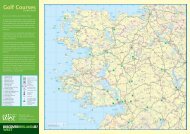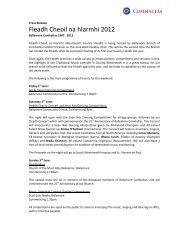Free Guide - Discover Ireland
Free Guide - Discover Ireland
Free Guide - Discover Ireland
You also want an ePaper? Increase the reach of your titles
YUMPU automatically turns print PDFs into web optimized ePapers that Google loves.
Navan<br />
Situated in the heart of the Boyne Valley,<br />
Navan is an ideal base from which to<br />
explore the nearby attractions of Brú ná<br />
Bóinne, the Hill of Tara, and the historic<br />
towns of Kells and Trim<br />
The burgeoning town of Navan lies at the confluence of the rivers<br />
Boyne and Blackwater. It is the county town, or administrative capital,<br />
of Co. Meath. The name Navan has long confused etymologists. It is<br />
thought that it may take its name from the Irish An Uaimh, meaning<br />
‘the cave’ or perhaps from Nuachongbhail, meaning ‘new habitation’.<br />
Navan lies at the confluence of the rivers<br />
Boyne and Blackwater which has long been<br />
a site of strategic importance. A burial site<br />
close to where the two rivers meet has<br />
been identified as Dún Dubchomair, where<br />
a Viking fleet is reputed to have landed.<br />
The Anglo-Normans also recognised the<br />
importance of this location and around<br />
1185 Joselyn de Angulo converted a<br />
nearby glacial mound into a motte and<br />
bailey castle. Legend tells that this mound<br />
was the burial site of Odhbha, the wife of<br />
Éremón, a Milesian invader from Spain<br />
(see Myths & Legends, p. 38). In the later<br />
medieval period Navan was a walled town<br />
and, like Trim, was an outpost of The Pale.<br />
36 FOR MORE INFORMATION GO TO WWW.DISCOVERIRELAND.IE/BOYNEVALLEY<br />
The ruins of Athlumney Castle facing<br />
Navan across the Boyne are located a<br />
short distance from the town. It consists<br />
of two distinct buildings; an original tower<br />
house built in the 15th century and a Tudor<br />
mansion built around 1600. The house was<br />
burned by the Maguire’s in 1649 rather<br />
than allow Oliver Cromwell shelter within<br />
its walls.<br />
Navan is famous for being the birthplace<br />
of Francis Beaufort (1774 - 1857), who<br />
developed the Beaufort Scale of wind<br />
force. In 1805 Commander (later Admiral)<br />
Beaufort published a method of measuring<br />
the wind at sea based on the sails a frigate

















